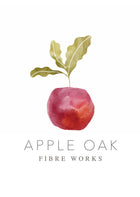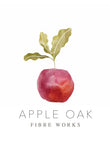Update On Our Dye Plant Variety Trials
Please join The Natural Dyers Academy's Co-Lab rooms for more details and future reports on the variety trials
Jeanne and Martina sowing the seeds of Woad, Weld and Madder for our variety trials
With April almost over, I finally have a moment to write this update on our variety trials. I was glad to have waited another 10 days before sowing, as the weather turned miserable for the last week of March. On the 4th of April, we decided to take the plunge and go ahead with sowing. It was quite a task, but many hands make light work, and with 4 of us, we managed to get the job done in 1 day.
To maximize use of space and minimize compost, we sowed our seeds in 150 cell plug trays, sowing 2 seeds per cell enabling us to sow 3 varieties per tray at 100 seeds of each variety. This worked for most varieties, though we were a little short of seed for a few of the varieties. The final count by the end of the day came to 4,751 seeds sown - 2,301 Woad, 2,250 Weld and 180 Madder.
Jeanne sowing decorticated woad seed
The end of a productive day with all Woad, Weld and Madder seeds sown along with some Coreopsis, Dyers Chamomile
Four days later and the first varieties of woad started to peep through the compost. The following day, the first of the weld varieties started to push through and by the 14th of April (10 days after sowing), most of the Woad and Weld varieties had germinated and were well on their way. I must admit, I was very excited after the long build up of sourcing all the seed.
Woad Varieties Just beginning to germinate
Madder is a much more laid back plant and only began to appear much later than the others, with the first variety only making a tentative appearance 11 days after sowing and not really getting going until the following week. Though I was glad to see them appear, as they have a very tough seed coat like sweet peas, which can inhibit germination.
Madder seedlings
Sowing seeds in 150 cell plug trays in an organic system, means that the seedlings are at risk of running out of nutrients and moisture very early on and must be potted on very quickly. With woad being a hungry crop, it was especially important to stay abreast of any deficiencies; so by the 20th of April, I was beginning to pot on the first of the woad varieties into 9cm square pots. From a slow cold spring, temperatures suddenly climbed into the 20s outdoors and into the 30s in the tunnel and it became imperative to pot on the rest of the woad. After a few long days, and 1,033 pots later, I was relieved to have all 18 woad varieties potted on (1 variety never germinated).
All 18 varieties of Woad and 8 varieties of Madder potted on into 9cm square pots
Differences in the woad varieties are beginning to show with some varieties displaying different shades of foliage and stems and various degrees of hairiness. With the weld however, there are no distinct characteristics emerging yet other than widely varying germination rates and speeds, with 3 varieties having very low germination rates and 2 varieties with no germination at all. As with the Weld, the madder is also not showing much differentiation between varieties yet, other than germination rates, with 2 varieties not germinating.
Woad seedlings from the variety trials
In the next 10 days the woad will go outside to harden off and the weld will be potted on while we begin the ground preparation in the field where they will be planted out.
Field in winter green manures where trials will be planted out
Please join The Natural Dyers Academy's Co-Lab rooms for more details and future reports.











Merci! That is very nice of you to say :)
Bonjour, je vous remercie pour votre travail et surtout vos analyses sur le pastel.
Je suis producteur de pastel également pour son pigment et son huile.
Je vous souhaite beaucoup de réussite et de découvertes avec vos plantes.
Au plaisir de vous lire.
Hinterlassen Sie einen Kommentar